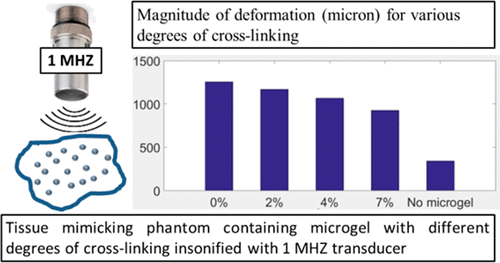Our official English website, www.x-mol.net, welcomes your feedback! (Note: you will need to create a separate account there.)
Study of Poly(N-isopropylacrylamide-co-acrylic acid) (pNIPAM) Microgel Particle Induced Deformations of Tissue-Mimicking Phantom by Ultrasound Stimulation
Langmuir ( IF 3.9 ) Pub Date : 2018-01-09 00:00:00 , DOI: 10.1021/acs.langmuir.7b02801 Aditya Joshi , Seema Nandi 1 , Daniel Chester 1 , Ashley C. Brown 1 , Marie Muller 1
Langmuir ( IF 3.9 ) Pub Date : 2018-01-09 00:00:00 , DOI: 10.1021/acs.langmuir.7b02801 Aditya Joshi , Seema Nandi 1 , Daniel Chester 1 , Ashley C. Brown 1 , Marie Muller 1
Affiliation

|
Poly(N-isopropylacrylamide) (pNIPAm) microgels (microgels) are colloidal particles that have been used extensively for biomedical applications. Typically, these particles are synthesized in the presence of an exogenous cross-linker, such as N,N′-methylenebis(acrylamide) (BIS); however, recent studies have demonstrated that pNIPAm microgels can be synthesized in the absence of an exogenous cross-linker, resulting in the formation of ultralow cross-linked (ULC) particles, which are highly deformable. Microgel deformability has been linked in certain cases to enhanced bioactivity when ULC microgels are used for the creation of biomimetic particles. We hypothesized that ultrasound stimulation of microgels would enhance particle deformation and that the degree of enhancement would negatively correlate with the degree of particle cross-linking. Here, we demonstrate in tissue-mimicking phantoms that using ultrasound insonification causes deformations of ULC microgel particles. Furthermore, the amount of deformation depends on the ultrasound excitation frequency and amplitude and on the concentration of ULC microgel particles. We observed that the amplitude of deformation increases with increasing ULC microgel particle concentration up to 2.5 mg/100 mL, but concentrations higher than 2.5 mg/100 mL result in reduced amount of deformation. In addition, we observed that the amplitude of deformation was significantly higher at 1 MHz insonification frequency. We also report that increasing the degree of microgel cross-linking reduces the magnitude of the deformation and increases the optimal concentration required to achieve the largest amount of deformation. Stimulated ULC microgel particle deformation has numerous potential biomedical applications, including enhancement of localized drug delivery and biomimetic activity. These results demonstrate the potential of ultrasound stimulation for such applications.
中文翻译:

聚(N-异丙基丙烯酰胺-共丙烯酸)(pNIPAM)微凝胶颗粒通过超声刺激诱导组织模拟体变形的研究
聚(N-异丙基丙烯酰胺)(pNIPAm)微凝胶(微凝胶)是胶体颗粒,已广泛用于生物医学应用。通常,这些颗粒是在外源性交联剂(例如N,N′-亚甲基双(丙烯酰胺)(BIS); 然而,最近的研究表明,pNIPAm微凝胶可以在不存在外源性交联剂的情况下合成,从而形成高度可变形的超低交联(ULC)颗粒。当ULC微凝胶用于产生仿生颗粒时,微凝胶的可变形性在某些情况下与增强的生物活性有关。我们假设超声刺激的微凝胶将增强粒子变形,并且增强的程度将与粒子的交联程度负相关。在这里,我们在模仿组织的幻象中证明了使用超声声化会导致ULC微凝胶颗粒变形。此外,变形量取决于超声激发频率和幅度以及ULC微凝胶颗粒的浓度。我们观察到,随着ULC微凝胶颗粒浓度增加到2.5 mg / 100 mL,变形的幅度增加,但是浓度高于2.5 mg / 100 mL导致变形量减少。此外,我们观察到,在1 MHz的声波频率下,变形幅度明显更高。我们还报告说,增加微凝胶的交联度会降低变形的幅度,并增加达到最大变形量所需的最佳浓度。刺激的ULC微凝胶颗粒变形具有许多潜在的生物医学应用,包括增强局部药物递送和仿生活性。
更新日期:2018-01-09
中文翻译:

聚(N-异丙基丙烯酰胺-共丙烯酸)(pNIPAM)微凝胶颗粒通过超声刺激诱导组织模拟体变形的研究
聚(N-异丙基丙烯酰胺)(pNIPAm)微凝胶(微凝胶)是胶体颗粒,已广泛用于生物医学应用。通常,这些颗粒是在外源性交联剂(例如N,N′-亚甲基双(丙烯酰胺)(BIS); 然而,最近的研究表明,pNIPAm微凝胶可以在不存在外源性交联剂的情况下合成,从而形成高度可变形的超低交联(ULC)颗粒。当ULC微凝胶用于产生仿生颗粒时,微凝胶的可变形性在某些情况下与增强的生物活性有关。我们假设超声刺激的微凝胶将增强粒子变形,并且增强的程度将与粒子的交联程度负相关。在这里,我们在模仿组织的幻象中证明了使用超声声化会导致ULC微凝胶颗粒变形。此外,变形量取决于超声激发频率和幅度以及ULC微凝胶颗粒的浓度。我们观察到,随着ULC微凝胶颗粒浓度增加到2.5 mg / 100 mL,变形的幅度增加,但是浓度高于2.5 mg / 100 mL导致变形量减少。此外,我们观察到,在1 MHz的声波频率下,变形幅度明显更高。我们还报告说,增加微凝胶的交联度会降低变形的幅度,并增加达到最大变形量所需的最佳浓度。刺激的ULC微凝胶颗粒变形具有许多潜在的生物医学应用,包括增强局部药物递送和仿生活性。



























 京公网安备 11010802027423号
京公网安备 11010802027423号